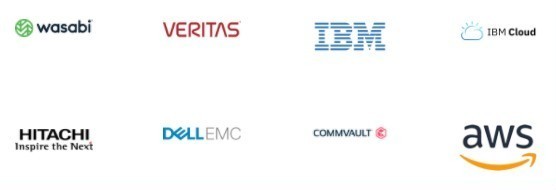AN INTERVIEW WITH TODD BROOKS, CEO OF FALCONSTOR

Todd, can you give us the lay of the current IT infrastructure landscape?
It’s exciting, to say the least! Very empowering but also confusing at times. Organizations of all sizes can now acquire high-quality, general purpose infrastructure software and technologies on an as-needed basis and provision them almost instantly. The advantages of being able to choose on-premise and cloud-based, virtualized infrastructure can be tremendous, especially in terms of lowering operational costs, speeding up deployments, and fostering business flexibility. But, with that upside comes the risk of vendor lock-in.
What do you mean by vendor lock-in?
Vendor lock-in happens when a customer becomes dependent on a supplier for a product or service and is unable to use another vendor without substantial switching costs or inconvenience.
As organizations move more applications and data into the cloud, avoiding vendor lock-in remains top-of-mind for many CIOs and their teams. We’ve all heard the horror stories of organizations who found themselves far too deep in a single cloud platform. A cloud provider shuts down operations, or an organization gets hacked and loses everything because they had no disaster recovery plan.
The flip side is that the fear of vendor lock-in may have stopped many enterprises from adopting the cloud at all, which has its own negative implications. Enterprises shouldn’t have to avoid the cloud entirely in order to avoid lock-in. The cloud has simply too much to offer to be avoided out of fear.
How can IT lead the way to avoiding lock-in and its opposite cousin, fragmented storage and data?
First, many organizations are still in the experimental stage with public cloud projects – it’s still early and missteps can be avoided or mitigated. Projects usually start out at the workgroup or departmental level, and then they tend to expand or be emulated by other departments, leading to a kind of de-facto, if unplanned, standardization.
IT departments can take a leadership role in avoiding lock-in and fragmentation by looking first at how they’re going to orchestrate their storage and data. IT can help the lines of business adopt and reap the benefits of cloud by owning data protection, data optimization, and recovery across ALL environments: physical, virtual, cloud, and hybrid cloud environment, along with the associated SLAs around backup windows, high availability, and RPO and RTO.
The challenge is doing so in a complex heterogeneous environment.
What is particularly challenging about a heterogeneous environment?
One of the most frustrating aspects of managing IT is the heterogeneous nature of today’s data stores, with many different fragments of siloed storage solutions across physical, virtual, and cloud environments hindering any kind of universal orchestration. Switching from management console to management console makes administrative work unnecessarily complex and time-consuming, and the inability to manage storage solutions comprehensively can prevent an organization’s total storage capacity from being used efficiently. Even team resources cannot be allocated efficiently because different people have to be assigned to manage each system or cloud solution with which they have gained expertise.
Over time, as a result of these obstacles, IT decision makers often find themselves facing another type of lock-in similar to the cloud vendor lock-in: hardware vendor lock-in. A single storage hardware vendor may improve efficiency in the short term, but it’s a move that can inhibit flexibility and agility for IT in the long term.
Is this where FalconStor comes in?
Exactly. With FalconStor, you can make use of your existing IT investments and gain a holistic and empowering view of your heterogeneous storage environment through a central management console that includes embedded, pervasive security. This universal orchestration is possible because FalconStor solutions are vendor-agnostic, and for this reason, you don’t need to “start over” with new infrastructure or get locked-in to one hardware or cloud vendor to try to streamline it all. We have designed, validated, and certified our software to work with what you’ve got, which means no lock-in and no need to rip-and-replace.
Customers tell us time and again that one of the things they love most about our solutions is the fact that they are designed to work with their existing technology investments and can scale and adapt to their changing needs and to emerging technologies. This is becoming increasingly important as customers begin using our solutions to manage storage and data in the cloud.
Describe some use cases where this might be an important consideration.
There are three cloud use cases that are of particular interest to our customers and that are easily deployed with our solutions.
First, customers can export tapes to the cloud and stop physically moving tapes offsite for storage. We are seeing this use case a lot, particularly in customer environments with IBM i infrastructure, where modernization of the backup environment is a key objective.
Second, and we believe this use case will just grow in importance, is customers using the cloud as their secondary copy of data for the ultimate in low-cost protection and site security. Customers are also wanting to migrate their storage and workspaces to the cloud to eliminate data center equipment expenses, maintenance, and support.
And finally, to avoid the cloud vendor lock-in we discussed earlier, we are seeing that customers want to protect their data in the cloud by replicating to other cloud sites or vendors for maximum security of their data and insurance against cloud pricing changes or other vendor-related issues.
What are some other benefits of a vendor-agnostic data management solution?
There are three key benefits of our vendor-agnostic approach, particularly in the hybrid cloud use cases I just talked about. All are designed to magnify peace-of-mind when it comes to leveraging existing investments and avoiding lock-in.
First, we bring down costs by helping IT leverage their existing investments. No rip-and-replace, no need to start over.
Second, we avoid fragmented data management because we address the full stack of data management needs – protection, optimization, recovery, location, analysis, and scalability.
Third, we enable scalability. Customers can easily add and leverage new technologies – particularly cloud – as they become available.
Is this an approach that sets FalconStor apart from others in this space?
Our vendor-agnostic approach is a key tenet that is built into all of our solutions and is what really sets FalconStor apart from others in this space. No other data management vendor can holistically help you achieve mastery over your data and enable your adoption of cloud without creating lock-in, further propagating silos, compromising on data protection and recovery, or requiring rip-and-replace. And, we have nearly two decades experience doing this. We understand the challenges of storage and data management inside and out.
Thanks, Todd. What else would you like to tell our blog readers and subscribers?
First, thanks for stopping by the Data Mastery Blog. I hope that our content is informative and helpful. If you haven’t subscribed yet, we’d like to invite you now. We’d love to show you our solution in action, so contact us today – Request a Demo!


